
SanCCS (Call Center Solution)
The most advanced call center solutions in the industry.
SanCCS (Hosted Call Center Solution)
SanCCS Hosted solution works with Zero Hardware Requirement.
EasyGoIVR (Hosted IVR)
Cloud based service which give you real time seamless call reporting.
SanE-Visa (Immigration CRM)
CRM to manage Leads, Status, College fee Structures, Invoice.
VedaERP (LMS and ERP Software)
Cloud based ERP solution to track all streamline accounting process.
SanTMS (Ticket Management)
SanTMS allows you to manage your customer tickets.
SanTrans (Transport Management)
Manages all routine transport transactions.
SanORDO (Order Management)
Automates and streamline order processing for businesses.
To connect multi-branches office over internet to voice call.
- TeamInspector
WhatsApp Chat Monitoring Software
SanOBD (IVR Blasting)
Ultimate IVR broadcasting software system
AI enabled IVR Bot system
Cloud bases service which give you real time seamless call reporting.
Cloud based ERP solution to track all steamline accounting process.
Automates and steamlines order processing for businesses.
SanCBS (Call Billing Software)
Optimize your billing with ERP software.
- Our Clients
- Pricing Plans
Call support and sales are still prominent options to provide support to the customers. According to a report on the customer experience rate of 2020, almost 66% of customers use a phone support system instead of any other support channel. After seeing this fact, you might be thinking of starting a call center but starting a call center is not an easy task. It requires careful planning, and it’s easy to get tripped up along the way.
Here’s a step-by-step guide to establishing the finest call center for your business.
List of Steps On How To Start a Call Center in India
Determine your objectives.
Before you get into the details of running a call center, first of all, find out or question yourself that why you need one. Consider what you’ll need to run a successful call center business after you’ve established the key goals of your call center. Your particular organizational needs will determine your primary goals:
- If you own a small business or a startup, your primary aim may be to enhance lead generation, get new customers, or simplify payment and order processing.
- If you manage a larger company, perhaps your primary aim is to improve client happiness and general support.
Once your primary goals have been defined, you must utilize call center metrics that may serve as key performance indicators (KPIs) to assess the effectiveness of your call center services. It’s also vital to remember that your call center’s aims will most likely differ from those of your contact center.
- Contact centers utilize a variety of channels (email, social media, live chat, etc.)
- Call centers only provide service through standard telephone lines.
A call center must be more efficient because everything happens in real-time, and there isn’t always time to think about a response. In fact, phone assistance has the highest expectations of any channel, with approximately half of the consumers expecting a response in less than five minutes.
Set Your Budget
You must first set a budget before proceeding with the setup process of your call center for your company. Determine how much money you can reasonably invest in operating a contact center. This can assist you in determining specifics about how your call center will function, such as:
- Size of office and location
- Types of tools and software
To obtain a better understanding of how much money you can spend, compile your monthly income streams, fixed expenditures, and variable expenses before creating a budget for your contact center. You may discover that creating an on-site call center is not financially easy, which can assist you in deciding on a great remote workforce choice.
Decide the Call Center Type
Determining the primary goal(s) of your contact support center can help you determine which kind of call center will best suit your business needs. Depending on your requirements, there are a few different types of call centers to choose from.
Inbound vs. Outbound Call Centers
Inbound contact centers.
Do you make cold calls to targeted clients with telesales offers? Or are you totally into resolving client complaints? The answers to these questions will help you decide whether to set up an incoming (inbound) or outgoing (outbound) call center for your company. Inbound Call Center Solution handle incoming calls and are often managed by customer service representatives. These representatives assist callers in resolving difficulties with your product or service.
Normally, this kind of call center is perfect for:
- Product and/or technical assistance
- Order and payment processing
- Inquiries about upgrades and renewals
Outbound Contact Centers
Outbound Call Center Software perform outgoing phone calls to individuals . They are normally performed by sales teams looking to promote a product or service or gather market data that is relevant to broader business concepts.
In general, this kind of call center is suitable for:
- Making an appointment
- Telemarketing
- Lead generation
There’s also the option of using a hybrid call center, which can handle both inbound and outgoing calls. Some businesses choose a hybrid strategy so that they can provide a consistent client experience from a single call center.
Also Read: Guide on What are Inbound & Outbound Call Center Software
On-site vs. Virtual Call Centers
On-site contact centers.
Do you need an in-house call center with a large office area, or are you seeking a remote call center? Which is a more cost-effective solution. Both choices are now available to company owners, and each has its own set of advantages. On-site call centers are actual premises where agents answer or make calls to the client or customers. The whole crew, as well as all of the equipment, is in one place.
Some of the benefits of an on-site call center include:
- Employees and management must communicate quickly and in person. Because everyone is in the same building, it’s simple to communicate with one another and handle any employee or customer difficulties.
- Real-time technology updates and training are more convenient. You are more capable of explaining the complexities of various technologies effectively and in person.
Also Read: How to Set Up an On-Premise Call Center Business in India?
Virtual Contact Centers
Virtual call centers are hosted in the cloud and have no physical infrastructure. Members of the team work remotely and may be located anywhere in the globe as long as they have a reliable Internet connection. Some of the advantages of a virtual call center are as follows:
- Having access to the best applicants from all around the world. The top prospects are not usually from your home nation. Examining overseas applicants with more experience might be beneficial.
- Having agents in several time zones allows for more flexible call center hours. Your clients may relax knowing they don’t have to sneak away at lunch to make a support call; they can do it whenever they have time.
- Spending less on buildings and more on call center software and personnel wages. You may keep your workforce satisfied by providing items like corporate laptops and better compensation while keeping your facilities and office supplies to a minimum.
Again, a hybrid call center with both on-site and virtual components is a possibility. This is also a wonderful alternative to provide employees with—the ability to work from a remote location as well as an office space, depending on employee desire.
Also Read: Get Virtual Call Center Software Solutions – SAN Softwares
Create Your Team
Once you have decided on your call center type, it is time to add some manpower in that call center that can help you to make your call center successful. Hire the best people for your call center Finding the best individuals for your call center is easier said than done. To begin, you must have a clear idea of your requirements. Make a list of the features an ideal support agent should possess:
- Is it necessary for them to be able to work flexible hours?
- How much prior experience do they need?
- Should they make small conversation or get down to business?
Answering these questions will give you a better understanding of the sorts of people you’ll want to invite in for interviews.
In a call center CV, you should also be extremely clear about your must-haves against your nice-to-haves. Many recruiters struggle to discover qualified applicants when they include too many mandatory conditions. If you believe something is valuable, include it as a nice-to-have and consider what you can educate your staff to perform once they are recruited.
Get Trained Your Agents and Supervisors
Provide agent training as part of your call center set up to ensure your representatives are adequately ready to accomplish their jobs. You may achieve this by training employees in an offsite location, such as another contact center, online, or on-site.
Agents should be trained on any headsets and phone systems that your firm utilizes. Agents in a virtual call center should be helped in setting up their remote workspace and should be familiar with all the tools and software used by your organization. You may help them by providing any call center training advice you have. Ensure that agents are also taught correct support center etiquette, and consider developing a call center script to assist newer staff and to keep the brand message consistent.
Get The Necessary Software And Tools
Outsourcing some of your company’s activities to an outside vendor or service provider is referred to as business process outsourcing (BPO). BPO in the context of a call center refers to the outsourcing of incoming and outbound services to agents who do not work for your firm.
This is an excellent alternative for businesses with limited bandwidth who want rapid assistance. If the number of calls exceeds your team’s capacity, it may be prudent to explore a BPO call center solution. You’ll be able to regulate the large volume of calls without hiring and training new personnel.
Inbound BPO call center services include the following:
- Handling support inquiries
- Order fulfillment
Outbound BPO call center services include the following:
- Market research
- Telemarketing
If you’re in a staffing jam and can’t acquire and train a large number of new employees, BPO call center solutions are appropriate. In general, these are call center agents with prior industry expertise and outstanding customer service abilities. There are much necessary software, tools, and digital resources that your call center and your agents may require, such as a powerful call center solution software, accounting software, knowledge base, and more.

Invest Money in The Culture
In the end, investing in culture would be a great step; with so many calls going place in a single day, working at a successful contact center may be overwhelming for everyone involved. That is why excellent leadership and management are essential when it comes to the operation of your contact center. To make your team feel supported, do the following:
- When dealing with staff, maintain a cool manner.
- Contact them on a frequent basis to check if they are experiencing any difficulties that you can assist them with.
When faced with a rush of calls on a busy day, these go a long way toward keeping call center personnel happy and supported. Once you’ve got all of your call center elements in place, make sure it’s a welcoming place to work. That way, you may keep your best employees while also bringing on new ones who will contribute to the company’s long-term success.
Want to Start a Call Center in India?
Are you looking for a powerful c all center software but concerned about call center setup cost in India? Well, SAN Softwares have a solution for you; they have one of the most affordable call center solution providing support to many Indian call centers. Try our SanCCS call center solution that can play a huge role in serving profits in your call center. It can drastically streamline your call center’s business process and provide better efficiency.
There are a plethora of features that support of run your call center more effectively:
- Automated Call Distribution
- Real-Time Analytics and Report
- Multilevel IVR
- Self Designable Web-Based CRM
- Seamless Integration
- Skill Based Routing
- Agent Performance MIS
- Unified Agent Desktop
- Click to call
- Thoughtful UI
- Omni Channel
- Customer service
Frequently Asked Questions
Recent blog:.
Schedule Your Demo Now
Start 7-day free trial today.
SAN Softwares is a company dedicated to providing complete software solutions to Corporate and end-user customers.
- SAN in Media
- Certification
Useful Links
- Privacy Policy
- Terms Of Use
- T&C(TeamInspector)
Our Services
- Custom Software Development
- WhatsApp Business Tool
- SanCCS(Cloud)
- SanCall Assist
Integrations
- IPPBX Zoho Integration
- IPPBX Salesforce Integration
- IPPBX Hubspot Integration
- Call Center Solution in India
- Call Center Solution in Canada
- Call Center Solution in USA
- Call Center Solution in UK
- Call Center Solution in UAE
- Call Center Solution in Nepal
- Certifications
- Zoho Integration With IPPBX
- Salesforce Integration with IPPBX
- HubSpot CRM Integration with IPPBX
- Call Center Solutions in India
- Call Center Solutions in Canada
- Call Center Solutions in USA
- Call Center Solutions in UK
- Call Center Solutions in UAE
- Call Center Solutions in Nepal
© 2024 SAN Softwares Pvt Ltd | All Right Reserved

How to Start a Call Center Business in 2024
Despite the recent rapid rise of digital communication channels and an increased demand for self-service support, phone still continues to dominate as the most preferred support channel. In fact, according to a Salesforce study , 59% of consumers favor traditional phone calls to reach a customer support representative. Phone sales are also here to stay as one of the most efficient and cost-effective ways for businesses to promote and sell their products or services.
If you’re looking to set up a call center business in 2024 and beyond, you’ve landed on the right page. While building your own call center – whether inbound, outbound, or blended – might seem too challenging to start, knowing exactly what to do will instantly blow your fears away.
Looking for a Contact Center Solution?
Powerful AI dialer, bulk SMS, and more tools for running an omnichannel contact center.
Based on VoiceSpin’s 15-year experience in the call center industry, we’ve decided to come up with a step-by-step guide on how to start a call center and walk you through every phase of the process.
- How to Start a Call Center Business in 10 Steps
- 1. Set Your Call Center Goals and Write a Business plan
Just like with any other business, building a call center requires careful planning. Before you actually start setting up your own call center, have a clear understanding of wh y you want to start a call center and outline the goals you are looking to achieve. Make sure, however, that these goals are specific, realistic, achievable given your current budget and resources, and align with your broader business objectives.
On top of that, setting goals will help you establish clear criteria for measuring performance (we’ll talk about call center metrics and KPIs in more detail below) and the overall success of your call center.
Based on your goals, write out a detailed business plan. The steps we discuss below will guide you in your business plan creation. Overall, your call center business plan should outline the following key points:
- Company description, your short-term and long-term goals, and objectives
- Market analysis, industry overview, and your major competitors
- Your organizational structure, management team, and hiring plan
- A comprehensive description of the services your call center will provide
- Your marketing plan and a sales strategy for promoting your services
- Operations plan describing your daily operations and facility and technology requirements
- Financial plan outlining your setup costs, ongoing operational expenses, and profit and loss statement
- Risk analysis with potential risks and strategies to mitigate them
- 2. Decide on Call Center Type
Inbound vs. outbound vs. blended call center
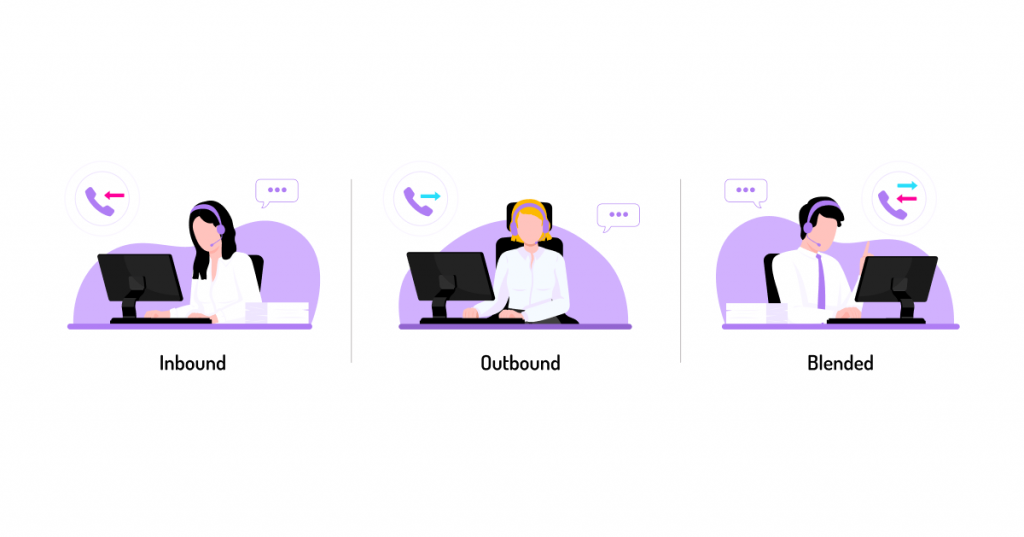
Inbound call center
Inbound call centers primarily deal with incoming calls from existing customers, clients, or prospects. Businesses set up inbound call centers for general customer service, technical support, processing orders, payments, returns, and exchanges, handling upgrades and renewal requests, appointment scheduling, and inbound sales. The most typical industries to benefit from inbound call centers are e-commerce and retail, travel and hospitality, healthcare, finance, and insurance.
Outbound call center
In outbound call centers, agents are placing outbound phone calls to prospects or customers. Outbound call centers are commonly used for lead generation, telemarketing, sales campaigns, appointment setting and reminders, debt collection, market research and CSAT surveys, etc. For providing outbound call center services, you need call center software with auto dialing capabilities that will enable you to automate the dialing process, so that agents don’t have to dial each number manually.
Blended call center
Blended call centers (also known as hybrid call centers) combine both inbound and outbound calling capabilities and are best suited for businesses that have relatively equal volumes of incoming and outgoing calls. Luckily, many call center software providers offer a fair share of features to support both inbound and outbound calling activities. E.g., VoiceSpin call center solutions are perfectly suited for inbound customer support and outbound sales teams alike.
On-site vs. remote vs. virtual call center
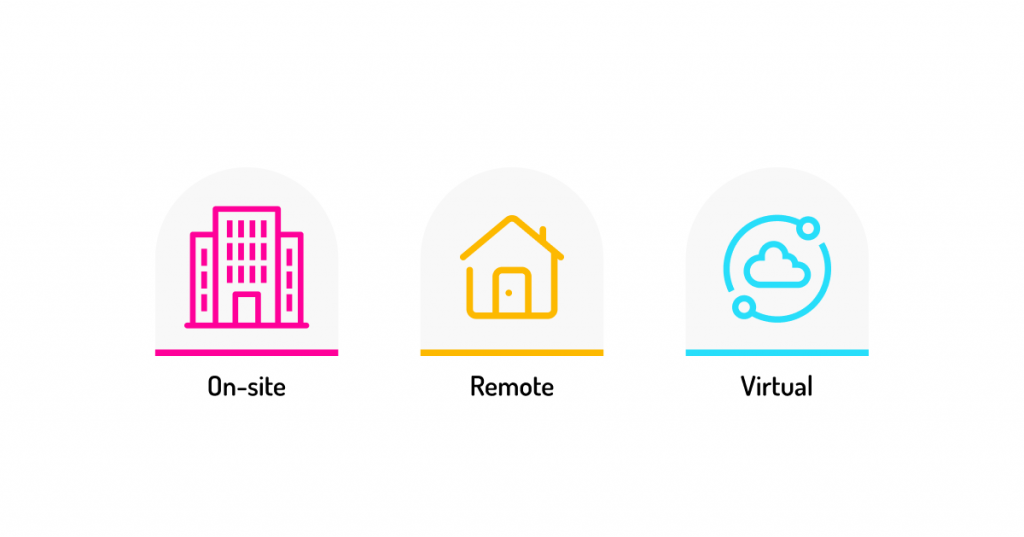
On-site call center
In a traditional on-site call center, agents are going to work from a physical location, which might be the best option for fixed-location businesses and those with large teams. Improved team collaboration, direct supervision, and increased data security are some of the advantages that will follow. However, there are also certain downsides to selecting on-site deployment, such as higher operational costs, a rather limited talent pool, and a lack of flexibility of remote working.
Remote call center
Remote call centers are entirely offsite call centers, typically powered by outsourcing. This might be an ideal option for small businesses and startups that would like to avoid paying for physical office space, office equipment, and hardware, making remote call centers much more cost-efficient compared to on-premises solutions. That also provides you with access to a broader talent pool while allowing greater flexibility for agents.
Virtual call center
Similarly to remote call centers, virtual call centers aren’t tied to one geographical location, with agents often being distributed across multiple regions, working from various remote locations. Virtual call centers run on cloud-based VoIP call center software , allowing agents to access the system and work from nearly everywhere, as long as there’s a stable internet connection. That offers businesses access to an even broader talent pool, easy scalability, and cost-efficiency.
Call center vs. omnichannel contact center
Call center
If you’re looking to set up a traditional call center where agents will only handle voice communications, you would basically need to purchase a business phone system with call-handling features like IVR, call routing, call forwarding, call transfer, call queueing, call recording, call reporting and analytics, click-to-call, auto dialing, etc.
Omnichannel contact center
If you’re planning to handle customer interactions across multiple communication channels, you may want to set up an omnichannel contact center that integrates both voice and digital communication channels like email, live chat, SMS, social media, and Instant Messaging apps. With an integrated solution, agents will be able to manage all interactions from one platform, with no need to switch between the apps, eliminating the risk of communication silos.
Related article: A Complete Guide to Omnichannel Contact Center
- 3. Establish a Budget
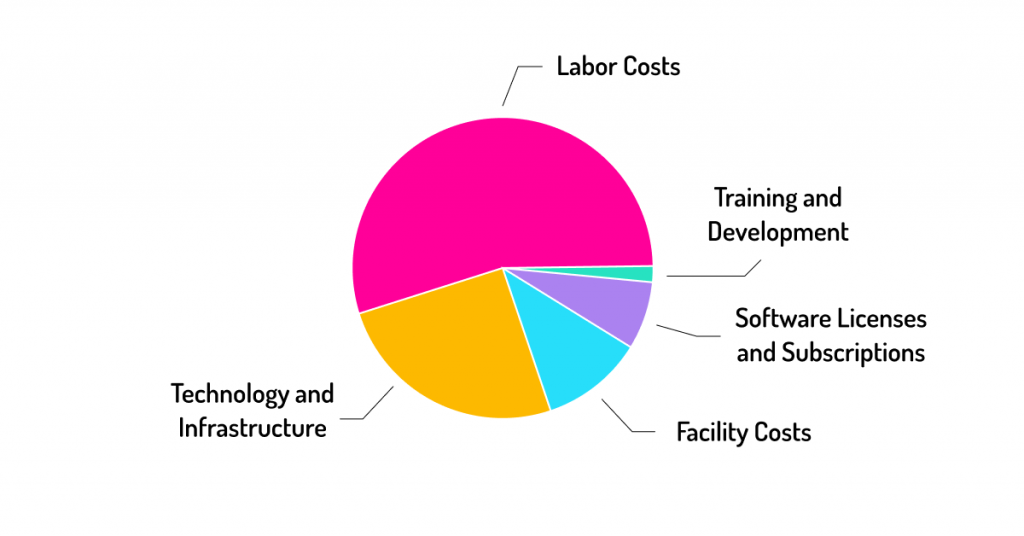
The total cost of setting up a call center will ultimately depend on a range of factors, such as the setup type, software and hardware, required features, the number of employees, etc.
Here’s what you should consider when putting together your budget:
- Office space and hardware : In addition to office space and office equipment expenses, running an on-site call center will also require you to pay for the hardware and infrastructure, not to mention ongoing maintenance fees and updates. However, you can eliminate office and hardware expenses by setting up a remote call center.
- Call center software: Take into account software licenses and set-up costs for on-premises tools and monthly subscription fees for cloud-based solutions. Pricing plans of cloud-based providers may differ based on the features offered in a specific pricing tier, the billing structure (fixed monthly fee, monthly fee per user, per-minute fee), and the number of users.
- Employee salaries: Agent salaries may significantly vary based on location and experience level. Besides, you may also encounter additional expenses that may come up later, such as rewards and incentives for top-performing agents, ongoing training costs, or expenses for holding team-building events, to name a few.
- Training and customer support: While most call center software providers include basic employee training and some level of customer support in their subscription plans, custom in-person training and 24/7 dedicated omnichannel customer support may require extra expenses, adding up to your overall costs.
- 4. Select Call Center Software Provider
On-premises vs. hosted vs. cloud-based
Once you’re clear on what type of call center you are going to run, it’s finally time to choose a call center software provider that will align with your business goals, IT resources, budget, and scalability needs.
Despite the popularity and increased adoption of cloud-based call center solutions, on-premises tools are still a large part of the industry. So, if you’re looking to own and manage the entire call center infrastructure, including hardware and servers, choose one of the on-premises call center software providers. With hosted call center tools or cloud-based solutions, the provider will manage all of that for you. These solutions are also easier scalable, more flexible, and can be quickly adapted to your evolving business needs.
Next, depending on whether you need to manage inbound calls or make outbound calls , you will need to evaluate potential providers based on the range of inbound/ outbound call center features they are offering.
These are some of the fundamental features to pay attention to when evaluating call center software vendors:
Inbound call center features
- Inbound call handling: Automatic Call Distribution ( ACD ), Interactive Voice Response ( IVR ), and advanced call routing options are some of the most basic features to look for when choosing an inbound call center software. E.g., with skill-based routing, you can ensure that inbound calls will be routed to the most appropriate agents based on their skill set, allowing for faster issue resolutions and improving your FCR scores.
- Call queue management: Call queue management capabilities are essential for call centers with typically high inbound call volumes. E.g., VoiceSpin’s queue callback feature enables callers to request a callback from an agent instead of having to wait on hold until an agent becomes available to handle their request. That helps reduce the number of dropped calls and improves customer service experience.
- Call recording and monitoring: The ability to record customer calls for compliance, quality assurance, and agent training purposes is a must-have feature for inbound call center solutions. Managers and supervisors should also be able to monitor calls in real time to evaluate call quality, assess agent performance, and identify agent training and coaching opportunities. In addition, features like call whispering and call barging are also valuable for supervisors.
- Integrations with CRM systems: The software’s ability to integrate with CRM (Customer Relationship Management) systems and other business apps is critical, as it provides agents with a 360-degree customer view, including the history of previous interactions, enabling agents to deliver more contextual and personalized interactions. That will also reduce manual work for agents, eliminate the need to switch between apps, and improve team performance.
Outbound call center features
- Auto dialing capabilities: For sales-oriented outbound call centers, auto dialing capabilities are key. E.g., VoiceSpin’s outbound call center software provides auto dialing as part of its call center package. The AI auto dialer enables agents to place hundreds or even thousands of outbound calls with minimal human input and minimizes agent idle time between calls thanks to predictive dialing, improving the efficiency of your outbound calling efforts.
- Lead and campaign management: Lead and campaign management features are also essential for outbound call center teams. Agents should be able to easily manage lead lists and outbound calling campaigns. VoiceSpin’s call center software can also automatically score and prioritize leads and connect them to the best-fitting agents based on the probability of making a successful sale, improving conversion rates of outbound calling campaigns.
- Local caller ID: Local presence dialing and local Caller ID are must-have features for running outbound calling campaigns in multiple, geographically distributed locations. Since people aren’t likely to answer calls from unknown numbers, being able to display a local number on the Caller ID will instantly increase your Call Answer Rates , meaning your sales agents can engage in more conversations and convert more leads.
- Reporting and analytics: Reporting and analytics features are equally important for both inbound and outbound call centers. By leveraging reporting tools, call center managers can monitor critical call center metrics and KPIs, evaluate the effectiveness of calling campaigns, keep tabs on agent performance, uncover inefficiencies in the process and operations, and make more data-driven decisions on the necessary improvements.
Advanced AI-powered features and omnichannel capabilities
- AI speech analytics: In addition to the core call center features listed above, you may want to look for innovative AI-driven capabilities such as speech analytics. AI speech analytics solutions can help you automate and optimize your entire call center quality assurance process, ensure compliance, and identify improvement opportunities. E.g., VoiceSpin’s AI Speech Analyzer allows you to monitor the quality of customer interactions based on your custom rules and metrics and prevent non-compliance issues through keyword spotting and real-time alerts.
- AI call summaries: AI call summaries is an advanced feature you may want to pay attention to when evaluating potential call center software platforms. Call summaries are brief AI-generated recaps of the conversations between your agents and customers or prospects that include important insights extracted from each call. With access to AI call summaries, you don’t have to listen to call recordings or read the entire transcription of each call to evaluate the quality of interactions and your team’s performance.
- AI chatbots: Self-service chatbots are becoming increasingly popular among businesses and consumers. Based on Gartner’s research , chatbots will become the primary customer service channel for nearly a quarter of organizations by 2027 . If you’re looking to enhance your customer support with self-service options, consider call center solutions offering chatbots. AI chatbots will empower your customers to get support 24/7, find answers to their questions, and resolve issues independently without having to talk to your support reps.
- Omnichannel readiness: If you want to be able to scale your support offerings as your business grows, omnichannel capabilities are critical. By integrating multiple communication channels, including voice, email, live chat, social media, and instant messaging apps in one platform, you’ll be able to support your customers across all these channels using a single solution. That also means your agents will have the full context of previous interactions, enabling them to deliver omnichannel experiences regardless of the channels customers use.
- 5. Get Call Center Hardware and Equipment
If you opt for setting up an on-premises call center , you will need to invest in call center hardware and equipment. That may include a physical PBX (Private Branch Exchange) system, dedicated servers and data centers, telephony hardware, networking equipment, power supply systems and backup generators, desktop computers, headsets and VoIP phones, desks, office chairs, and other office equipment. All of that might require significant upfront investment that should be considered in your budget.
When setting up a cloud-based call center , you can eliminate the need for expensive hardware, making it an attractive option for smaller businesses. Thus, to set up and run a cloud-based call center, you would only need a high-speed internet connection with sufficient bandwidth for uninterrupted connection, computers, laptops, or other devices agents will use to access the call center software system, headsets, hardware VoIP phones, or softphones, and office equipment. The rest is managed and maintained by a cloud-based call center provider.
- 6. Determine Your Staffing Needs
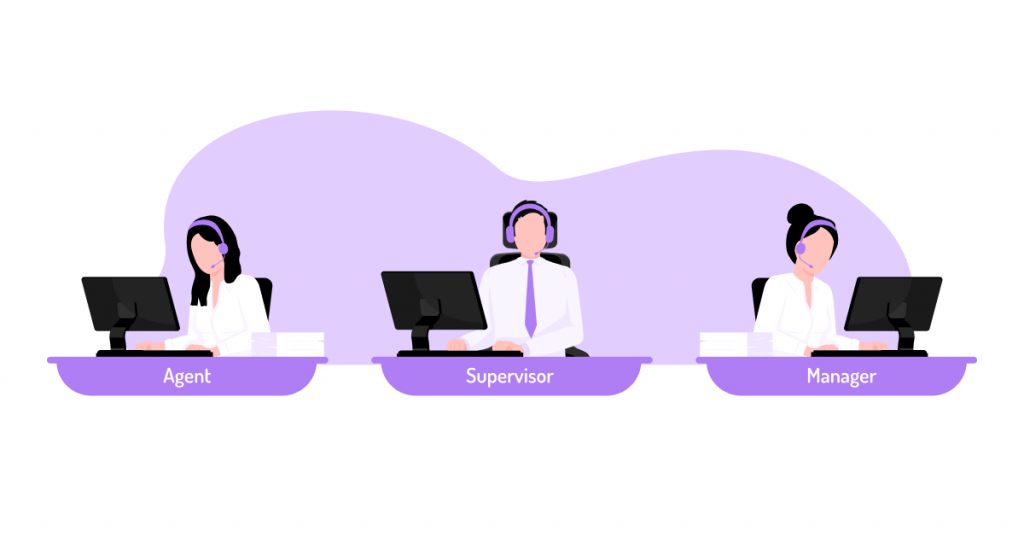
To run a successful call center, you need the right number of employees to handle inbound/ outbound calls and meet your performance goals. If you hire too few employees, your call center is going to be understaffed, resulting in long wait times for callers, an increased number of abandoned calls, and lower customer satisfaction scores. Hire too many – and agents are going to be underutilized, adding up to your overhead costs.
To estimate the number of required employees, you may need to take into account call volume, the average wait times and call handle times, the average number of missed/ abandoned calls, and other metrics and factors. You’ll also need to clearly define positions to be filled. While roles and titles may differ, the basic ones are:
- Call Center Agent: Call center agents are at the frontline of your call center, representing your business, directly communicating with prospects and customers, providing the necessary information, resolving requests, handling customer complaints, or selling your products or services. Agents report to supervisors.
- Call Center Supervisor: Supervisors are responsible for managing and supporting agents, arranging and providing training and call coaching sessions, measuring agent performance and ensuring they adhere to call center quality standards, giving regular feedback to agents, etc. Supervisors report to the call center manager.
- Call Center Manager : Call center managers set goals, performance expectations for agents and supervisors, and SLAs for a call center, plan and manage call center staffing levels (including recruitment, onboarding, and scheduling), conduct quality monitoring and call center Quality Assurance , analyze call center metrics and KPIs, etc. Managers report to the business owner.
- 7. Hire a Call Center Team
Call center jobs aren’t for everyone. Most of the time call center agents have to spend interacting with people (who may be frustrated or even abusive), answering their questions, helping them resolve issues, or selling products and services. When searching for, selecting, and interviewing potential candidates, hiring managers shouldn’t only focus on a person’s industry experience and familiarity with call center software systems and CRM tools. On top of that, it’s important to look for those who possess a variety of soft skills that are much-needed to succeed in the role, such as:
- Excellent communication skills: Along with active listening, clear verbal and written communication skills are fundamental for call center employees. Agents should be able to convey information in a clear and concise way that is easy for others to understand and act on.
- Empathy and emotional intelligence: An ability to demonstrate empathy and emotional intelligence when interacting with customers helps build rapport and trust with customers, which is why empathy and EI are vital skills to take into account when evaluating potential hires.
- Conflict-resolution: Challenging interactions and conflicts with dissatisfied customers or even colleagues are bound to happen. A candidate’s problem-solving and conflict-resolution skills and an ability to address customer complaints and de-escalate tense situations are a must-have.
- Ability to multitask: As agents may need to quickly switch between inbound and outbound calls or manage multiple communication channels (in the case of omnichannel contact centers), an ability to efficiently multitask and transition between various tasks is an essential skill to look for.
- Stress management: Agents would often need to work in high-pressure environments where they must handle challenging customer interactions, deal with irritated customers, and meet their performance metrics, making an ability to effectively manage job-related stress crucial.
- 8. Build Your Onboarding and Training Processes
In call centers, employee onboarding is often a lengthy and complicated process. But when done right, it results in many long-term benefits for call centers, such as improved engagement, increased agent efficiency, and reduced turnover rate. A Glassdoor survey found that organizations with a strong onboarding process are able to improve new hire productivity by over 70% and retention by 82%.
However, building a highly efficient call center team doesn’t end with proper onboarding. You should create a consistent process of ongoing learning through regular training and coaching initiatives. These are some of the examples of what your agent training materials, resources, and activities may include:
- A comprehensive internal knowledge base with FAQs
- Live or pre-recorded agent training webinars
- A library of successful customer interactions pulled from call recordings
- A library of scripts and canned responses for handling different types of calls
- Call-handling procedures, call flow, and call escalation protocols
- On-the-job training through live call whispering during customer interactions, etc.
- 9. Know How You Will Measure Call Center Performance
Based on your call center type (inbound/ outbound), your specific goals and objectives, and analytics capabilities of your call center software, you may track a different set of metrics and KPIs (Key Performance Indicators) that will allow you to measure the overall efficiency of your call center operations and performance of individual agents. These are some of the most common and most critical metrics and KPIs you may want to keep close tabs on:
The Average Handle Time (AHA): The Average Handle Time represents the average time it takes for an agent to handle a customer call, including hold time, talk time, and after-call work time. Along with other metrics, it’s a key indicator of how efficiently agents are able to handle customer inquiries. A high AHT may mean inefficient call routing or poor agent training.
The Average Speed of Answer (ASA): The Average Speed of Answer shows the average time callers have to wait in the queue before their call gets connected to an agent. A high ASA indicates that a call center may need to work on improving its operational efficiency and call management process, adjust staffing levels, or implement self-service options.
First Call Resolution (FCR): First Call Resolution Rate measures the percentage of customer issues resolved during the first interaction and shows how efficient your agents are in handling customer requests. A low FCR rate suggests that agents need more training or that they simply lack access to the necessary information and tools to resolve issues on the first call.
Call Abandonment Rate: Call Abandonment Rate is the percentage of calls terminated by customers before being connected to a customer support representative. A high abandonment rate is commonly caused by insufficient staffing levels, forcing callers to wait on hold for a considerably long time, poor call routing, and lack of callback options.
Customer Satisfaction (CSAT) Score: Customer Satisfaction (CSAT) Score measures the overall customer satisfaction with your product, service, or customer service and shows whether your call center is meeting customer expectations. A low CSAT score related to your service quality might mean that you need to work on improving your ASA, AHT, and FCR rates.
Conversion Rate: Conversion rate is an essential metric for sales-focused outbound call centers, which shows the percentage of outbound calls that resulted in a successful outcome (a closed deal, a booked appointment, etc.). A low conversion rate might be an indicator of low lead list quality or that the agents require more training.
Related article: Top 10 Outbound Call Center Metrics Your Call Center Should Measure
- 10. Build a Supportive Call Center Environment
Call centers are known to have traditionally high employee turnover rates due to the intense and stressful nature of the job, which is a huge problem for businesses. Not only is it because hiring, successfully onboarding, and training new agents takes time, much effort, and financial resources, but also because when agents leave – that may disrupt your call center operations and negatively impact the morale of the remaining team members. That is why it’s essential to build and consistently maintain a positive and supportive workplace environment within your call center. Here’s what you can do:
- Allow for flexible scheduling and remote work options to help agents achieve a better work-life balance.
- Maintain a psychologically safe environment where agents are encouraged to share their opinions and suggestions.
- Regularly provide and collect feedback from agents through one-on-one meetings.
- Hold team-building events in and out of the office to boost employee morale and engagement.
- Develop and implement an employee recognition program and reward top-performing agents.
Related article: How to Build an Efficient Call Center Environment to Drive Agent Performance
- Bonus: Be Aware of the Common Challenges and How to Overcome Them
Legal and regulatory compliance
Maintaining legal and regulatory compliance is critical in the call center industry, as it ensures your call center adheres to laws, relevant regulations, standards, and ethical practices. More importantly, failing to do so may lead to penalties, hefty fines, reputational damage, and loss of customer trust. Research all the relevant rules, regulations, and applicable laws related to your industry in your particular area and create a clear compliance policy and guidelines for your agents to follow. Here are some of the most common call center compliance regulations to adhere to:
- TCPA (Telephone Consumer Protection Act): TCPA is a U.S. federal law that regulates telemarketing calls and the use of auto dialers, pre-recorded messages, and SMS and is aimed to protect consumers from unwanted sales calls. It also maintains a Do Not Call (DNC) list.
- GDPR (General Data Protection Regulation): Requires call centers to obtain consent from consumers before recording calls. GDPR is designed to protect the privacy and personal data of individuals within the European Union.
- HIPAA (Health Insurance Portability and Accountability Act): HIPAA is a U.S. federal law designed to protect sensitive patient health information from being disclosed without the patient’s consent or knowledge.
High employee turnover rates
We’ve already mentioned this earlier, the call center industry is known for having typically high turnover rates. While the industry standard for call center turnover is 30-40%, some call centers have agent turnover as high as over 200% , based on research by SQM Group . With the average cost to replace a call center agent being around $10,000 to $20,000, according to Harvard Business Review researcher Keith Ferrazzi, failing to retain employees might significantly add to your operational costs. To avoid being affected by high agent turnover rates, you should have a clear strategy in place to address this challenge.
Expected or unexpected call volume spikes
Managing expected or unexpected call volume spikes effectively without compromising service quality is a common challenge call centers face. When call volumes are higher than anticipated, wait times for callers increase, more calls are abandoned before being connected to an agent, and customer satisfaction ultimately drops. Moreover, that increases workload and creates additional pressure for agents, resulting in increased burnout, reduced workplace satisfaction, and higher turnover rates.
To handle this challenge, make sure to build an effective workforce management strategy with flexible schedules that can adjust to predicted call volumes, ensuring that there are always enough reps during peak call times. Additionally, leverage historical data and predictive analytics to forecast call volumes more accurately.
- Set up Your Omnichannel Contact Center with VoiceSpin
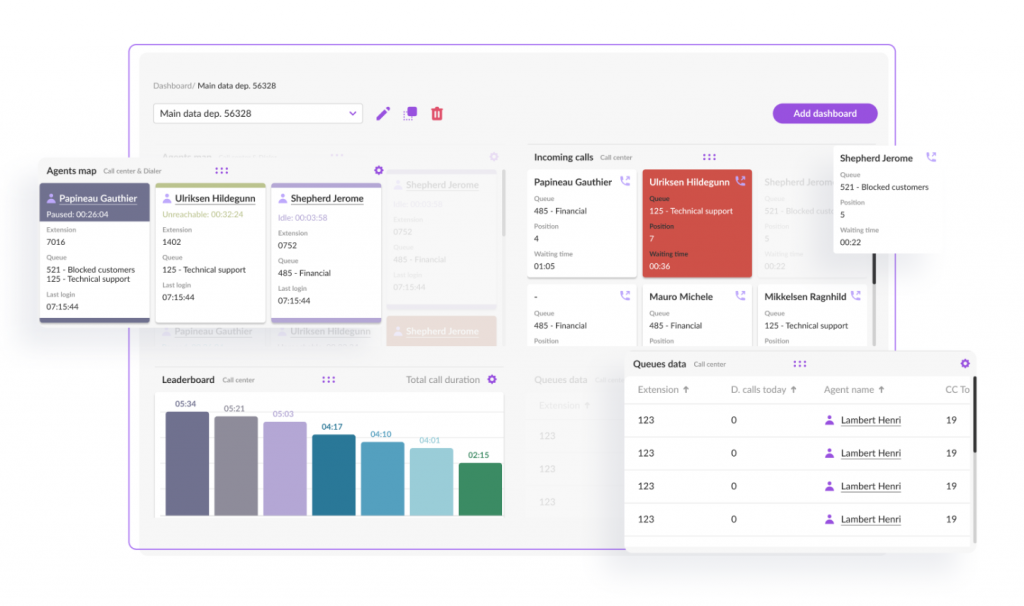
That all being said, why should you start your journey with VoiceSpin? Whether you’re just looking to set up your call center from scratch or researching alternative options to upgrade your current call center tech stack, VoiceSpin’s AI-powered contact center solutions might be the right fit for both customer support and sales-oriented teams, empowering them with the tools they need to support clients across multiple communication channels or sell faster and more efficiently. What’s more, you can seamlessly integrate your contact center with your CRM or other business tools to keep all data in sync and enable your teams to be even more productive.
Book a demo call now to get a tailored walkthrough of the features and how to get started.
Want to Supercharge Your Sales Team?
All the call center features you would expect and much more. Integrations included!
Share this article:
You'll like it

It takes a great deal of time and effort to cultivate and maintain a highly…
May 24, 2023
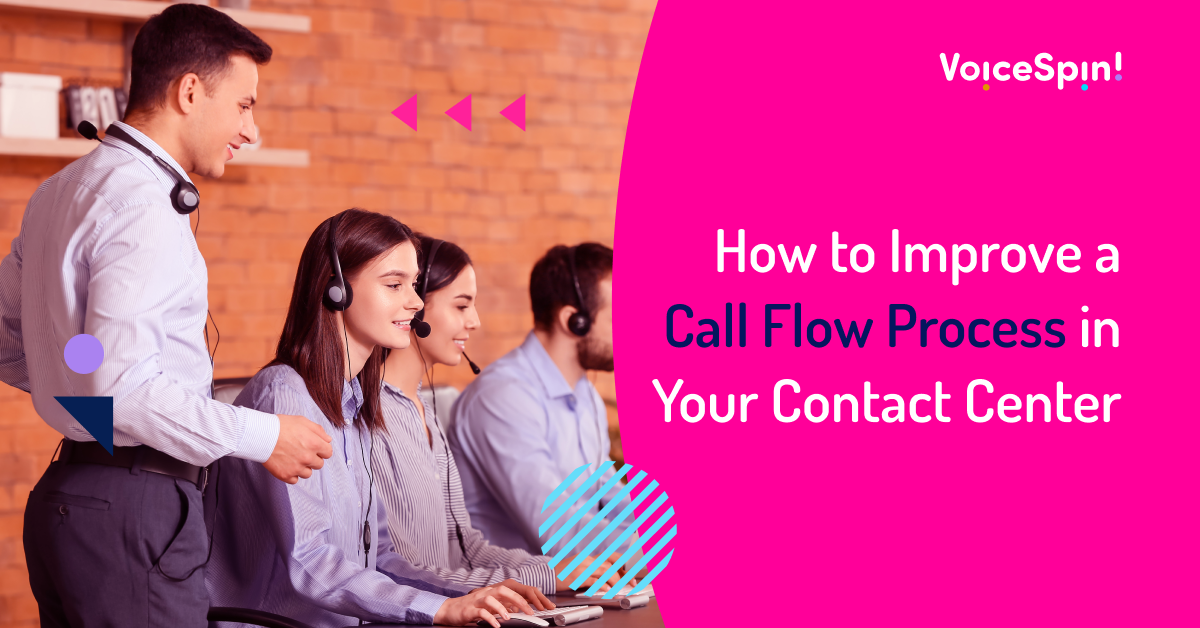
When customers call your business, how easily can they navigate through your IVR system? How…
April 14, 2023
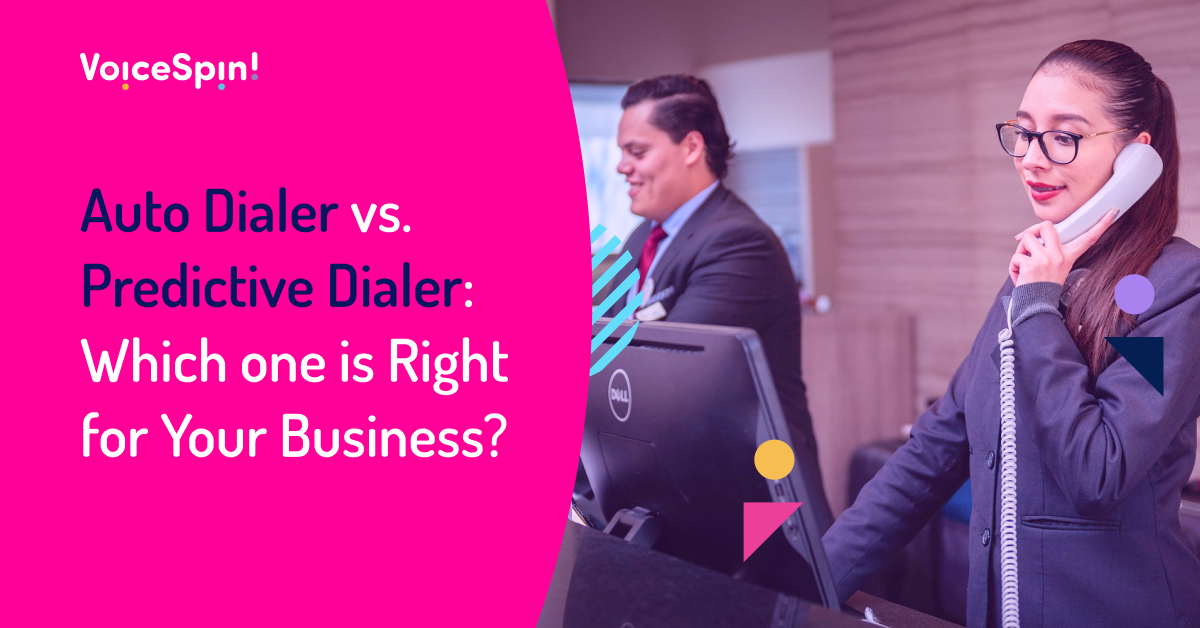
When it comes to running outbound calling campaigns, automation can make all the difference. By…
February 27, 2023
Some text in the Modal..
Want to know more? Contact us now
Privacy overview.
| Cookie | Duration | Description |
|---|---|---|
| cookielawinfo-checkbox-analytics | 11 months | This cookie is set by GDPR Cookie Consent plugin. The cookie is used to store the user consent for the cookies in the category "Analytics". |
| cookielawinfo-checkbox-functional | 11 months | The cookie is set by GDPR cookie consent to record the user consent for the cookies in the category "Functional". |
| cookielawinfo-checkbox-necessary | 11 months | This cookie is set by GDPR Cookie Consent plugin. The cookies is used to store the user consent for the cookies in the category "Necessary". |
| cookielawinfo-checkbox-others | 11 months | This cookie is set by GDPR Cookie Consent plugin. The cookie is used to store the user consent for the cookies in the category "Other. |
| cookielawinfo-checkbox-performance | 11 months | This cookie is set by GDPR Cookie Consent plugin. The cookie is used to store the user consent for the cookies in the category "Performance". |
| viewed_cookie_policy | 11 months | The cookie is set by the GDPR Cookie Consent plugin and is used to store whether or not user has consented to the use of cookies. It does not store any personal data. |

IMAGES
VIDEO
COMMENTS
कॉल सेण्टर बिज़नेस शुरू करने की प्रक्रिया (Step by Step process to start Call Center in India in Hindi): अपना Call Center खोलने या कॉल सेण्टर का बिज़नेस करने के लिए उद्यमी को ...
अगर आप Call Centre का बिज़नेस शुरू करना चाहते हैं, तो आप को क्या करना होगा? किन चीज़ों ...
Title: CALL CENTER BUSINESS IDEAS IN HINDI, How to start a call center business in India, Call Centre Startup, Best Business Ideas, New Business Ideas 2021Na...
Learn our expert insights on opening a call center in India with SAN Softwares' Call center solutions. Get started today for seamless operations and growth!
Start your Call Center Business in 2024 with our step-by-step guide! Discover efficient and cost-effective strategies for phone sales and customer support.
This video explains call center project map and step-by-step business plan to start your own call center.